A MESSAGE FROM
JOHN McGRATH
COVID-19 has certainly turned a lot of long term trends in Australian property on their head. We are embracing immense change and enjoying many new choices relating to where we live, the type of homes we buy or build, our personal lifestyles and our ability to generate wealth through property.
Our theme for the McGrath Report 2023 is ‘chaos creates opportunity’. To me, the most interesting elements of the pandemic wash-up in our market are the reversal of some decades-old trends; the rise of the regions; the renaissance in the way we are living; and that many of us — particularly young millennials — are no longer necessarily constrained by big city affordability challenges.
Over the past 25 years, as Australian property has risen in value substantially — particularly in Sydney and Melbourne — affordability has forced many people to learn how to live in smaller spaces.
Along the way, the traditional Australian dream of a house on a quarter acre block changed. In its place, the desire for property ownership of any kind
took over and we saw interesting new trends, such as families adopting apartment living in lifestyle locations and young people ‘rentvesting’.
COVID-19 has changed all this. The emergence of the home workplace has allowed people to buy larger homes in locations that suit their budgets and provide their dream lifestyles.
With work no longer anchoring people to the capital cities, we are seeing a significant scattering of the population to the regions, as well as outlying areas of major cities where large residential blocks of land and a sense of tranquil rural life combines with everything we love about city living, such as close proximity to shopping hubs, buzzing local café villages, and high quality restaurants.
As a nation of sun, sea and sand lovers, our most renowned coastal areas were the first to benefit. But as we explore in this year’s report, the ‘beach first’ mentality is shifting as many buyers find better value for money in Australia’s inland regions, including wine country and hinterland areas.
In addition to location changes, we’re also seeing a redesign of the ‘ideal’ home. Having separate office spaces for mum and dad to work, and the kids to study, has never been so prioritised.
As SJB architect Adam Haddow discusses in our report, people want their work spaces to be light and have a relationship with the outdoors, with a bit of separation between work and home areas.
The universal desire for open plan living — popularised in the 1990s — is changing as homeowners seek to create more flexible, separate zones using sliding doors, screens and partitions to enable privacy from other household members.
Now let’s talk about the market. The inevitable turn has begun, presenting new opportunities for buyers and sellers alike. Here are my thoughts on where we are headed over the next 12 months.
I’ve been through at least six market corrections in the last 40 years and this is certainly one of the fastest, with values down 10-15% in many areas of the East Coast.
But remember, this decline is coming off a 35-40% increase in the past few years. Queensland is showing more resilience but will probably see a similar correction eventually.
The unusual pace of this correction is directly related to the pace of official interest rate rises. But home loan rates are still well below the historical average for Australia, which is above 7%.
During the pandemic, many people used savings from not travelling and not going to gyms, cafes and restaurants during lockdowns to deleverage their debt.
A lot of that money is sitting in mortgage offset accounts, saving homeowners interest and giving them a cash buffer to comfortably absorb the impact of rising inflation and interest rates.
If you look at history, these periods of correction do not last long. In 2023, buyers will have more time to shop around while the market takes a breather over the next 12 months.
I think we have already seen the majority of price reductions due this cycle but it may get a little worse before it plateaus. I don’t foresee a huge rush of buyers coming in before prices rebound but the window of opportunity won’t last forever.
Smart money certainly loves uncertain times. Think of the ‘early adopters’ who left the big cities for the regions in 2020 and caught the massive wave of capital growth that ensued.
What are your opportunities in the 2023 market?
I hope you enjoy this year’s report.
JOHN McGRATH MANAGING DIRECTOR AND CEO

HAS COVID-19
REDESIGNED THE HOME?
Adam Haddow Director, SJB
One of the strongest influences on residential design has been the concern about health and hygiene. The widespread introduction of indoor plumbing and sewerage systems in 19th century England led to a reduction in the spread of waterborne illnesses1, while tiled bathrooms and simplified interior architecture were designed to stop germharbouring dust from collecting2.
So it was perhaps inevitable that COVID-19 would also leave its mark on residential design. But as our lives have become more complex, so has the design response, with considerations expanding beyond matters of hygiene to patterns of work and living, as well as notions of privacy and wellbeing.
As the seriousness of the pandemic revealed itself in March 2020, companies that usually relied on office workers directed their staff to work remotely from home to minimise the risk of infection. Roy Morgan research shows that by June 2020 onethird of Australian workers had set up offices at home3 but more than a year later, the Australian Bureau of Statistics (ABS) reported that figure had jumped to 40%4.

The subsequent impact on residential design was immediate and profound. Research by the National Australia Bank in early 2022 revealed that demand for a dedicated home office was still strong in NSW and Victoria, the two states most affected by the government-imposed lockdowns5 . And as workers grow accustomed to less commuting and a better work/life balance, all indicators suggest that a new hybrid model, combining the traditional office and a dedicated home work space, is here to stay6. The word ‘study’ is also one of the most popular search terms for buyers who are scouring property websites.
Adam Haddow, the Director of award-winning architecture and design studio, SJB, said while a desk space in the corner of a bedroom or working at the dining room table sufficed in the early days of the pandemic, two years on homeowners are looking for long-term solutions that promote productivity and wellbeing.
“People want a relationship with outdoor space, with light and a proper desk,” he said. “They also want a bit of separation between work and home.”
While not everyone will be investing in top line home offices with built-in joinery, a separate, private room with good sound insulation has become a priority for many hybrid office workers. For double income households, two home offices are better than one, with all creative solutions considered, from those within the floorplan, like attic spaces, to prefabricated studios in the backyard7
Separation has also become a key theme in open plan living. Already under scrutiny prior to the pandemic, the limitations of this style of living, popularised in the 1990s8, became evident during the pandemic as household members who were spending more time together than ever before went in search of privacy. Haddow said the result was more of the existing floor space being used more of the time.
“WE USED TO USE ABOUT 20% OF THE HOUSE ABOUT 80% OF THE TIME, AND NOW WE ARE USING 80% OF THE HOUSE 80% OF THE TIME.”
Architects and design experts now predict that greater interest in creating separate zones within a broader open kitchen, living and dining area will accelerate, with sliding doors, screens and partitions providing both visual and even acoustic privacy. The emphasis will be on flexible spaces that can be used for different purposes as circumstances require9, such as kitchen island benches that can double as homeschooling hubs.
Overwhelmed by the pressures of lockdowns and fear of infection during COVID-19, residents turned to their homes for respite, with the renovation market buoyed by money that would have otherwise been spent on overseas holidays10. Dissatisfied with their spaces, now that they were living and working there 24/7, homeowners were looking to make big and small changes that would improve their everyday experiences11 . Even small changes were seen as worthwhile.
As Haddow said: “At the start of COVID, if you went to Bunnings, everyone was buying plants and paint.”
Materials such as copper, brass and bronze, which are naturally germ resistant, have surged in popularity as an easy, low-tech ‘fix’ for handles and doorknobs, while smart home technology and voice activated devices reduce the objects and surfaces that are touched around the home12
Interest in creating relaxing gardens and outdoor entertaining areas also escalated during COVID-19, with demand for backyard pools particularly high13.
Whatever the space available, whether it is a backyard, balcony or roof garden, the desire for a private outdoor space — especially one that connects with internal rooms — is expected to remain strong even though restrictions have been lifted14

WELLBEING AND COMPANIONSHIP WERE ALSO BIG DRIVERS BEHIND SURGING PET OWNERSHIP DURING THE PANDEMIC.
IN GENERAL TERMS, GOOD NATURAL LIGHT, VENTILATION AND A CONNECTION BETWEEN THE INDOORS AND OUTDOORS HAVE LONG BEEN CONSIDERED DESIRABLE IN RESIDENTIAL SPACES, WITH COVID-19 SERVING AS A TIMELY REMINDER.
Wellbeing and companionship were also big drivers behind surging pet ownership during the pandemic.
While Australia already enjoyed one of the highest rates of pet ownership in the world15, the pandemic has focused attention on the needs of pets like never before. Design adaptations such as pet door flaps, built-in litter trays and dog washing stations have led to terms like ‘barkitecture’ — architecture for dogs — entering the design lexicon16.
If there is one room in the house that embodies all the pressures and anxieties of COVID-19 together, it’s the bathroom. It became a ‘world within a world’ during the pandemic, offering a sense of respite, relaxation and germ-free cleanliness.
Design had already shifted towards creating ‘day spa’ environments before working from home fully kicked in, but homeowners are increasingly opting for light, airy spaces finished in high end, natural materials such as stone (or stone look) and timber17. For those who can afford it, buyers are spending on statement freestanding baths, rainwater-style showerheads, underfloor heating and built-in sound systems.
As is the case with so many aspects of our lives in the past two years, while COVID-19 is not solely responsible for changes in residential design, it has certainly accelerated the conversation about what it means to live a more holistic lifestyle in the 21st century, with a sharper focus on health, mental wellbeing and flexible working arrangements.
Homeowners are becoming more assertive in their decisions about how they configure their homes to best suit their needs, opting for adaptable, multipurpose floor plans that are also suiting a growing number of buyers.
IS AUSTRALIA’S PLACE IN THE SUN
SET TO RISE?

When Australia closed its borders in March 2020 to slow the spread of COVID-19, no one expected it would be nearly two, long years before we once again welcomed the world with open arms.
The sudden absence of new migrants, international students and foreign investors shone a light on just how important these groups are to the Australian economy.
From filling vital roles in our workforce and providing much-needed funding for our universities and colleges, to renting and buying homes, arrivals from overseas have a positive economic, social and cultural impact on Australia. They also love our laidback lifestyle and continue to hold the safety and freedom offered to them in Australia in high regard1.
AFTER THE COUNTRY’S BORDERS REOPENED IN DECEMBER 2021, HIGHER THAN EXPECTED ARRIVALS FORCED THE FEDERAL GOVERNMENT TO REVISE ITS POPULATION FORECASTS FOR THE 2021-22 FINANCIAL YEAR 2 .
More than 130,000 international students alone arrived between December 2021 and March 2022, and new grants of offshore visas, most notably for working holiday makers, also significantly increased, lifting occupancy rates and revenue across the short-term accommodation rental market.
Expats also returned home in record numbers. According to Knight Frank’s 2021 Global Buyer Survey, 39% of surveyed expats had purchased property in Australia having returned home during the pandemic. Around 20% bought a primary residence, 7% a second home, and 11% a 50/50 home they may retire to in the long term. A further 18% opted to rent3
Despite these arrivals, the return of overseas migration and the subsequent demand for housing is expected to be slow, in part due to a blow-out in visa processing times, policies in travellers’ home countries and the time and cost associated with travelling to Australia4. Net overseas migration is forecast to return to pre-COVID-19 trends and remain steady at 235,000 people from 2024-25 onwards5.
MANY CITIES AND REGIONAL AREAS OF AUSTRALIA ARE FACING A RENTAL CRISIS, WITH LOW VACANCY RATES AND INCREASING RENTS.
However, CoreLogic has reported a recovery in many of the markets adversely affected by the pandemic, citing a decline in listing numbers and the return of temporary migrants, such as university students and visitors, as factors in that recovery6 .
In fact many cities and regional areas of Australia are facing a rental crisis, with low vacancy rates and increasing rents.
A LONG-RUNNING DOWNTURN IN INVESTMENT ACTIVITY HAS CONTRIBUTED TO A SHORTAGE OF RENTAL STOCK, AS HAS HIGHER DEMAND FROM OVERSEAS MIGRATION, WHICH IS EXPECTED TO KEEP UPWARDS PRESSURE ON RENTS7.
Property professionals who took part in a NAB Residential Property Survey expect rents across the country to grow well above average levels in 2022-23, and with average growth in rents over this period set to outpace house price growth, gross yields should also rise8.
CoreLogic Research Director Tim Lawless said with borders reopened and migration normalising, we can expect rental demand to increase even further, especially across inner city precincts and international education hubs9.
Lawless said factors that could offset a further tightening in vacancy rates might include larger rental households, as renters tackle higher rental costs by maximising occupancy per property, and a rise in investment activity that could deliver more rental housing.
The number and value of real estate approvals for foreign investors dropped in 2020-2110, and after rising to a two-year high in the first three months of 2022, dropped again in the second quarter 11 . The strongest demand is from U.S. and Singapore buyers, with Chinese investors in the mix but in reduced numbers12.
Lawless said there are still headwinds that are likely to keep foreign buyer activity below previous highs, such as high application fees, vacancy taxes and higher transactional costs in some states.
MIGRANTS SHOW A TENDENCY TO SETTLE IN MAJOR URBAN AREAS OF AUSTRALIA, WITH THE MAJORITY CALLING SYDNEY, MELBOURNE OR
PERTH
HOME.
The Federal Government has also alluded to further increases in foreign buyer fees as a channel to fund new housing policies.
Other experts expect foreign investor activity to remain subdued in the wake of rising interest rates and a market downturn. An exception may be if rental yields continue to rise and attract investors, especially those from Asia who are drawn to Australia’s relative economic and political stability13.
Social demographer Bernard Salt said the country’s real estate prospects are underpinned by population growth, which remains high by global western standards.
“AS AUSTRALIA RECOVERS FROM COVID AND RATCHETS UP IMMIGRATION, THIS WILL HEIGHTEN DEMAND FOR ALL TYPES OF REAL ESTATE PRODUCT 14.”
Whilst overseas migration will ultimately add to housing demand and support prices over the medium to long term, Lawless said most migrants will generally rent before they buy.
CoreLogic research shows a typical ‘tenure cycle’ for migrants begins with renting and shared accommodation. Then home ownership increases over time so that the proportion of overseas migrants who eventually own property is on par with the Australian-born population.
There are a variety of factors that determine where migrants will want to live. These include employment opportunities, housing affordability, visa conditions, the location of friends or family, and the makeup of the community.
According to Australian Bureau of Statistics 2021 census data, 30% of people living in Victoria were born overseas, while in NSW it’s 29.3%, Queensland 22.7% and Western Australia 32.2%15.
Migrants show a tendency to settle in major urban areas of Australia, with the majority calling Sydney, Melbourne or Perth home16.
In Sydney, international students are drawn to suburbs such as Haymarket, the CBD and Ultimo, which are near universities and further education institutions, whilst immigrants have been shown to favour areas that are already home to large numbers of their compatriots, such as the Northern Beaches, Parramatta, Burwood, Fairfield and CanterburyBankstown.
In Melbourne, students are drawn to the CBD, Carlton and Southbank whilst immigrants are spread across many areas of the city.
Brisbane’s Sunnybank has become known as “Little Asia”, and immigrants from the UK account for the largest group of migrants on the Gold Coast17
Regardless of where they settle, migrants add a richness and diversity to our suburbs that is fundamental to the Australian way of life. But whilst migrants and international students are returning and placing pressure on our rental markets, their numbers won’t get back to preCOVID-19 levels for another two or three years. The resulting impact on property prices is expected to be small at first, but will grow over time.


FRINGE BENEFITS
WHY YOUR NEIGHBOURING SUBURB COULD BE A BETTER BUY

The pandemic property boom across metropolitan and regional areas has put bridesmaid suburbs into focus, as more buyers widen their search to incorporate more affordable neighbouring areas on the fringes of their desired suburb.
A move to a new home so close to the old one may mean a slightly longer walk to favourite cafes and shops, but it also comes with good knowledge of the area so home buyers don’t feel they have to start from scratch when building community connections.
ELIZA OWEN, HEAD OF RESIDENTIAL RESEARCH
AT
CORELOGIC,
EXPLAINED THAT DURING HOUSING MARKET UPSWINGS, HIGHLY DESIRABLE AREAS ARE AMONGST THE FIRST TO MOVE.
Then, as interest rate conditions change, or people get priced out of these markets, buyers start to look for value next door.
For example, in Melbourne’s Bayside local government area, home to the blue ribbon suburb of Brighton which has a median house price of $2.4 million, values in nearby Highett, which has a median price of $1.7 million, took off by 18.9% over the 12 months to April 20221.
On the other side of town, the annual growth rate in Bayswater was 15.7% (median house price $935,887) over the same period, whilst the median in neighbouring Heathmont was $1.1 million2.
In western Sydney, house prices in Kings Park rose annually by 18.3% to a median of $1.05 million, compared with next door at Kings Langley where the median was $1.2 million3
In Edensor Park, 40km west of Sydney, house prices grew annually by 23.6% to a median of $1.1 million — a more affordable option than $1.3 million next door in Cecil Hills4.
In Brisbane, house prices rose in the 12 months to April 2022 by 33.8% in Keperra in the city’s north. Its median price of $851,494 was a more affordable option than its neighbour, Enoggera, at $1.1 million5
Also in Brisbane, house prices in Acacia Ridge increased annually by a staggering 37.9% to a median price of $665,044. This compares with Coopers Plains, which is more expensive, at a median of $885,348.
EVENTUALLY, ALL BOOMS PETER OUT, AND BY EARLY 2022, HOUSE PRICE GROWTH IN SYDNEY AND MELBOURNE HAD GONE INTO NEGATIVE TERRITORY.
When a housing market moves into a downturn there is often a patchwork effect at the start, according to CoreLogic. Expensive suburbs tend to see a fall in demand first because they aren’t as affordable under tighter credit conditions. Then demand often spills over into the next affordable, nearby market.
Some of these cooling suburbs began offering new value to buyers in the first three months of 2022. In Sydney, Melbourne and pockets of Tasmania and the ACT, buyers were discovering improving affordability in suburbs they couldn’t afford in 2021, particularly in inner and middle ring areas, which were the first into the downturn.
For example, in Sydney’s inner suburb of Alexandria, the median house price dropped 4.8% in the first three months of 2022 to $1,969,099, while the neighbouring, more affordable suburb of Mascot (median price $1,812,562) only pulled back 0.5% 6 .
In the northern middle ring suburb of Gladesville, the median house price held steady over the same period at $2,956,522, while next door in the more affordable suburb of Ryde, the median house price rose 2.8% to $2,368,7327.
In the Melbourne suburb of Coburg, 8km from the CBD, house prices dipped 2.4% to a median $1,311,885, while next door in the more affordable Coburg North, prices rose 1.5% to $1,088,494.
Similarly in inner city Port Melbourne, house prices fell 1.6% to $1,798,763, while in next door Spotswood they rose 3.1% to $1,274,7798
IN SYDNEY, MELBOURNE AND POCKETS OF TASMANIA AND THE ACT, BUYERS
ARE DISCOVERING
AT A CITYWIDE LEVEL IN SYDNEY AND MELBOURNE, MANY OF THE OUTER SUBURBS CONTINUED TO GROW WHILE THE INNER AND MIDDLE RINGS WERE COOLING.
In Canberra, house prices in the middle ring suburb of Mawson dipped 0.9% to a median $1,153,533, while in neighbouring Phillip, where the median was only $637,391, growth over the same period was 9.3%.
In the same time frame, median house prices in one of Hobart’s premier suburbs, Sandy Bay, cooled by 0.8% to $1,433,837, while in more affordable Mount Nelson next door, there was an uptick in median prices of 1.7% to $999,320.
At a citywide level in Sydney and Melbourne, many of the outer suburbs continued to grow while the inner and middle rings were cooling.
Experts believe one possible reason for this is that these higher-priced suburbs in the inner and middle rings have buyers who are more stretched, in terms of their debt-to-income ratios, when interest rates rise.
THESE AREAS ARE ALSO USUALLY THE FIRST TO SHOW A RECOVERY TREND THROUGH THE START OF AN UPSWING, SO BUYERS MAY BE RELATIVELY QUICK TO LOOK TO THESE MARKETS WHEN PRICES COOL.
During the second quarter of 2022, these cooling prices extended past the inner and middle rings into much of the outer suburbs of Sydney and Melbourne, so that by July more than 80% of suburbs in both cities had recorded declining value9

IN THESE OUTER AREAS, WE SAW THE SAME TREND. SOME SUBURBS WITH HIGHER MEDIAN VALUES FELL FASTER THAN THEIR LESS EXPENSIVE NEIGHBOURS, WHICH IN SOME CASES CONTINUED TO GROW IN VALUE11 .
For example, in Sydney’s outer west, the suburb of Ropes Crossing, 49km from the CBD and with a median of $799,619, cooled by 1.9% in the three months to July, while its less expensive neighbour, Willmot (median $716,488) increased by 1.2%10 .
In the Melbourne suburb of Emerald, 44km southeast of the CBD, the median house price dipped 1.5% to $1,030,597, yet in next door Cockatoo, the median nudged up by 0.1% to be $899,03411
Buyers looking for value in the property market are turning to bridesmaid suburbs when their first-choice neighbourhoods next door are out of reach. These suburbs offer the familiarity and convenience without the higher price tag.
But with cooling prices comes opportunity, and many of these more expensive neighbourhoods will come back into contention as values continue to readjust.
FROM THE BEACH TO THE BUSH
ARE WE SEEING A POSTCODE SHIFT?

There is one place we Australians have traditionally loved to live and that’s by the coast. And it’s easy to see why. Our beaches are amongst the best in the world and our climate means we can enjoy them almost all year round.
When the pandemic came along it created an opportunity where we didn’t need to be tied to big cities for work, so we went looking for our perfect patch of sand. The only trouble is that laidback life by the seaside is getting harder to find — and afford.
HOUSE PRICES IN TOWNS ALL ALONG THE COASTAL FRINGES HAVE SKYROCKETED IN THE PAST TWO YEARS, IN SOME CASES TO BE ON PAR WITH OUR BIG CITIES.
These affordability constraints have forced many capital city escapees to look elsewhere, and many are choosing bush over beach.
The ease of working remotely has also opened the door to many who may have considered a treechange in the past, but up until the pandemic felt hemmed in by the need to be physically present at their workplace.
NOW THEY CAN SATISFY THAT YEARNING FOR A PROPERTY ON A LARGER BLOCK WHERE THEY CAN SMELL THE FRESH AIR AND ENJOY VIEWS OF ROLLING PADDOCKS.
Whether it’s beach or bush, Australians are increasingly moving away from capital cities. The latest Australian Bureau of Statistics (ABS) figures show that for the 2020-21 financial year populations across regional Australia grew by 70,900, or 0.9%, while the number of people living in capital cities decreased by 26,000, or -0.1%1.
But a deeper dive into the data shows that the ‘beach first’ mentality is shifting as many home buyers find better value for money in Australia’s inland regions.
Three of the top five local government areas by growth in migration in 2021 were inland regions: Western Downs, Queensland, 48%; Mount Gambier, South Australia, 44%; and Banana, Queensland, 40%2
A DEEPER DIVE INTO THE DATA SHOWS THAT THE ‘BEACH FIRST’ MENTALITY IS SHIFTING AS MANY HOME BUYERS FIND BETTER VALUE FOR MONEY IN AUSTRALIA’S INLAND REGIONS.
MANY TREECHANGERS ARE ALSO HANKERING FOR A SLOWER PACE OF LIFE AND A CHANCE TO CONNECT WITH THEIR NEIGHBOURS — SOMETHING MADE DIFFICULT WITH HECTIC CITY LIFE.
Experts say people form attachments through “physical, social or economic interactions and connections within the neighbourhood” and these things can influence the desire to move3. Country towns have this in spades.
This shift from capital cities has resulted in a boom in many small town populations. So much so that it has marked the first time since 1981 that regional populations have grown more than the capital cities4. It shows that a regional lifestyle is now more attractive than ever.
In 2020-21, regional NSW welcomed an extra 26,800 residents, regional Queensland an extra 24,100 and Victoria an extra 15,700. Populations in the regional areas of South Australia, Tasmania and Western Australia grew by between 1,000 and 2,000 people5
In Victoria, the greatest population losses occurred in the urban local government areas of Melbourne, Port Phillip and Stonnington as well as areas around universities, such as Monash, which experienced losses in international student numbers during the pandemic. In NSW, the largest population declines were in Sydney, Mosman, Willoughby and North Sydney6
SOME COUNCILS ARE CONCERNED THEIR TOWNS DO NOT HAVE ENOUGH ACCOMMODATION FOR NEWLY ARRIVED RESIDENTS.
Employment opportunities are a key driver for those planning on a career change or a new workplace to accompany a move to the bush. Data shows there were 84,600 job vacancies in regional Australia in April 2022 — 24.8% more than a year earlier7
Perhaps one of the only downsides of regional population growth is the availability of housing. Some councils are concerned their towns do not have enough accommodation, particularly rental accommodation, for newly arrived residents. In Victoria alone it’s projected that 87,400 additional dwellings will be required in rural areas over the next 15 years8.
AFFORDABILITY PLAYS A LARGE PART IN PEOPLE’S DECISIONS ON WHERE TO LIVE, AND IN THE REGIONS THERE’S AFFORDABILITY IN ABUNDANCE.
The regional median house price in NSW is $775,792 — almost half the median house price in Sydney at $1,346,193. In regional Victoria the median house price is $627,942 compared with Melbourne at $964,9509.
EVEN IN POPULAR REGIONAL AREAS, DWELLING VALUES REMAIN SUBSTANTIALLY LOWER THAN IN THE CITIES, DESPITE INTERNAL MIGRATION PUSHING UP PRICES10.
These areas are also more affordable than popular seachange towns such as Noosa Heads, where the median house price is $2,027,00011 compared with regional Queensland at $569,06212, and Byron Bay where people are paying a median house price of $3,150,000 13 — $2.37 million more than the rest of regional NSW.
Nevertheless, as populations increase in regional areas, so do property values. Price rises in some areas can be linked to them offering desirable lifestyles for treechangers.
The Hunter Valley in NSW, an area synonymous with acclaimed wineries and restaurants, has attracted many buyers keen to trade in the hustle and bustle of the rat race for a slower, calmer pace of life. The area recorded an annual growth rate for houses of 34.3% to April 202214, which made it the best performing non-capital city housing market in the country, and outstripping popular coastal regions such as the Shoalhaven on the state’s south coast.
Central Queensland, where many city dwellers from the southern states have also moved, recorded the largest uptick in sales volumes for houses of 42.9% in the year to February 2022.
It shares this record with the New England and North West region of NSW15, which offers large blocks in rural settings.
Both of these treechange areas pipped coastal areas in Queensland, including Townsville (41.2%), the Greater Whitsunday (40.8%) and Cairns (35.6%) regions16.
ESCAPEES FROM THE CITY HAVE BEEN FLOCKING TO THE BUSH FOR THE AFFORDABILITY, RELAXED LIFESTYLE, STRONG SENSE OF COMMUNITY AND WIDE OPEN SPACES.
However, those who put their shift off for much longer may find that there are fewer properties to choose from. Maybe it’s time to make that treechange once and for all.

SYDNEY

SURROUNDS
MEDIAN HOUSE PRICE
$1,302,635
MEDIAN APARTMENT PRICE
$799,150
CORELOGIC, SEPTEMBER 2022
Two years of phenomenal capital gains have changed the lives of Sydney homeowners, with the median house price rising 33% over 20201 and 20212 to peak at about $1,400,000 in early 2022 before the correction began.
In the 12 months to April 2022, the strongest house price gains were seen in the council areas of The Hills Shire (39.7% to a median $1,718,000), Lane Cove (37% to $3,430,000), Northern Beaches (36.8% to $2,750,000), Ryde (34.3% to $2,350,000) and Randwick (33.5% to $3,100,000)3
AS IS USUAL IN MARKET CORRECTIONS, SYDNEY WENT FROM BLANKET GROWTH TO A PATCHWORK OF RISING AND FALLING VALUES.
Inner and middle ring areas began cooling first, with house prices in a third of suburbs — mainly across the inner city, inner east and inner west — falling by 3%-7% over the three months to April 20224.
Prices in the outer ring and southwest continued rising by 4%-7%, reflecting the ongoing trend in work-from-home families upgrading to larger, more affordable houses away from the city.
Sydney first home buyers are struggling with affordability, and the Bank of Mum and Dad is still actively helping. The First Home Loan Deposit Scheme, now called the First Home Guarantee, is becoming less relevant in Sydney, with only about 12% of suburbs5 having a median house price below the $900,000 cap for FY236.
The NSW Government budget announcement that first home buyers will be able to choose between paying stamp duty upfront or an annual property tax of $400 plus 0.3% of the land value on homes bought for up to $1.5 million7 may assist young people with the deposit hurdle.

SECOND HOME BUYERS AND FAMILIES ARE ALSO GRAPPLING WITH AFFORDABILITY, WITH A RECORD GAP BETWEEN AUSTRALIAN HOUSE AND APARTMENT PRICES8 MAKING IT HARDER THAN EVER TO MOVE UP FROM STRATA LIVING TO LAND OWNERSHIP.
Sydney’s wealthy continues to invest tens of millions into prestige property. In FY22, returning expats competed against locals for large homes with recreational facilities. High demand and short supply led to a re-rating of prestige values in many areas.
Palm Beach had the highest annual growth amongst suburbs with a $5 million-plus median, at 59%9.
Also flying high was Dover Heights (up 54% to $6,400,000), Bronte (51% to $5,750,000) and Double Bay (44.5% to $6,340,000).

TWO YEARS OF PHENOMENAL CAPITAL GAINS HAVE CHANGED THE LIVES OF SYDNEY HOMEOWNERS.

Sydney affluence has spread to the NSW regions, where many families are retaining their lifestyle homes in areas such as the Southern Highlands but are now purchasing city ‘boltholes’ to make the transition back to working in their CBD offices easier.
In FY22, the NSW Government released the blueprint for the Western Parkland City, one of three interconnected hubs envisioned to reshape Sydney over the next 20 years.
It outlines a “green, connected and advanced city in its own right”10 featuring Australia’s first hydrogen and electric vehicle-ready, zero carbon urban centre11, and a green canopy so vast that it will change the climate of western Sydney 12 .
As the Sydney market cools, homeowners should look to history for comfort and guidance. Sydney house prices have a 10-year annual compound growth rate of 9% — the highest of any capital city — but that growth does not occur in a straight line13. There are dips in between, and that’s where Sydney is now.
JOHN M c GRATH’S
TOP PICKS
EDGECLIFF
Forever the bridesmaid, never the bride when it comes to its surrounding suburbs, Edgecliff has shaken its tag as a thoroughfare thanks to a burgeoning set of modern apartments and traditional terraces. The convenience of the train station makes it an easy commute to the CBD (10 minutes) and the serene surrounds of Trumper Park and nearby Rushcutters Bay Park (your furry friends will thank you for living so close to one of the best dog parks in Sydney with harbour views!) makes this suburb more affordable for young professionals and small families after a taste of the sought-after eastern suburb lifestyle.
OATLEY
As a riverside suburb tucked away in Sydney’s middleclass heartlands, Oatley has been a well-worn track for tourists looking for a nature based getaway from the usual tourist destinations for years. But with COVID-19 awakening our appreciation for the outdoors, this suburb of St George is fast becoming home to those who love to see and experience natural bushland. Convenience is also King with its proximity to the airport, quick access to the CBD by road (hello Eastern Distributor) or rail, making it the perfect place to balance work, and life. Oh, and did we mention the Oatley Village Pie Shop — locals highly recommend the Beef Burgundy Pie if you find yourself famished.
BALGOWLAH HEIGHTS
This tightly held Northern Beaches suburb offers the ultimate in picturesque family living. Boasting large houses, harbour surrounds and direct access to national park bushland, it is an enviable postcode to occupy if you are a family looking to put down roots. While some neighbouring suburbs act as a gateway to the CBD and Manly, Balgowlah Heights remains undisturbed, making idyllic memories for kids frolicking from house to house. Out of the hustle and bustle of Manly but with the benefits of world class beaches and cafes, if you’re lucky enough to get in, you’ll never want to leave.
NORTH RICHMOND
At the foot of the Bells Line of Road tourist drive to the picturesque Blue Mountains, outdoor adventure is in abundance for the locals of postcode 2754. Bushwalking trails and strolling through the fresh food markets will become regular weekend activities for homeowners in this suburb. Considered less historic than its neighbouring suburb, North Richmond’s variety of housing options — from small blocks, long established residential, to large acreages, and new housing estates (Redbank) — offers something for everyone. If value for money and a slower pace of life within the city is for you, then add this suburb to your list today.
JINDABYNE — REGIONAL NEW SOUTH WALES
If you’re after a tree change that’s a shift change in lifestyle, look no further than Jindabyne. Nestled within the Snowy Monaro amongst the rolling hills and mountain ranges (including the famous Kosciuszko National Park), this laid back location offers the perfect escape from the hustle and bustle of city life. Whilst for some, things may feel a little slower, you’ll be sucked in by the locals whose welcomes are so warm you’ll quickly forget those crisp Winter mornings. Speaking of Winter, another upside of being a local is access to Australia’s finest (and endless) snow sports and back-country hiking, while other seasons provide the perfect backdrop for hiking, biking, and water sports.
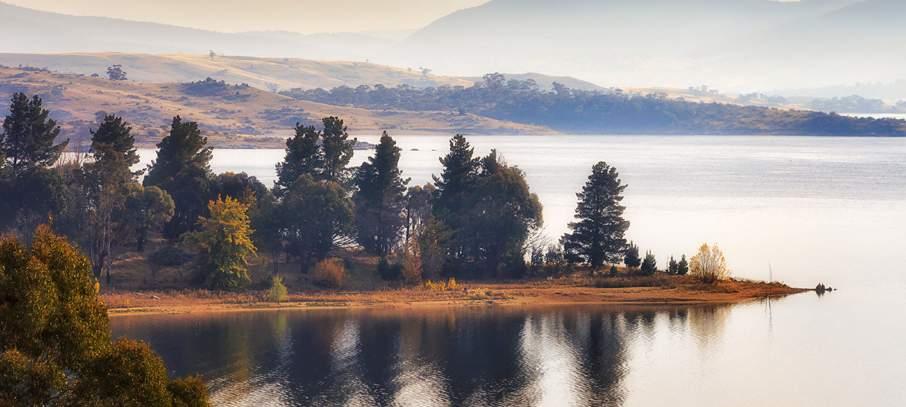
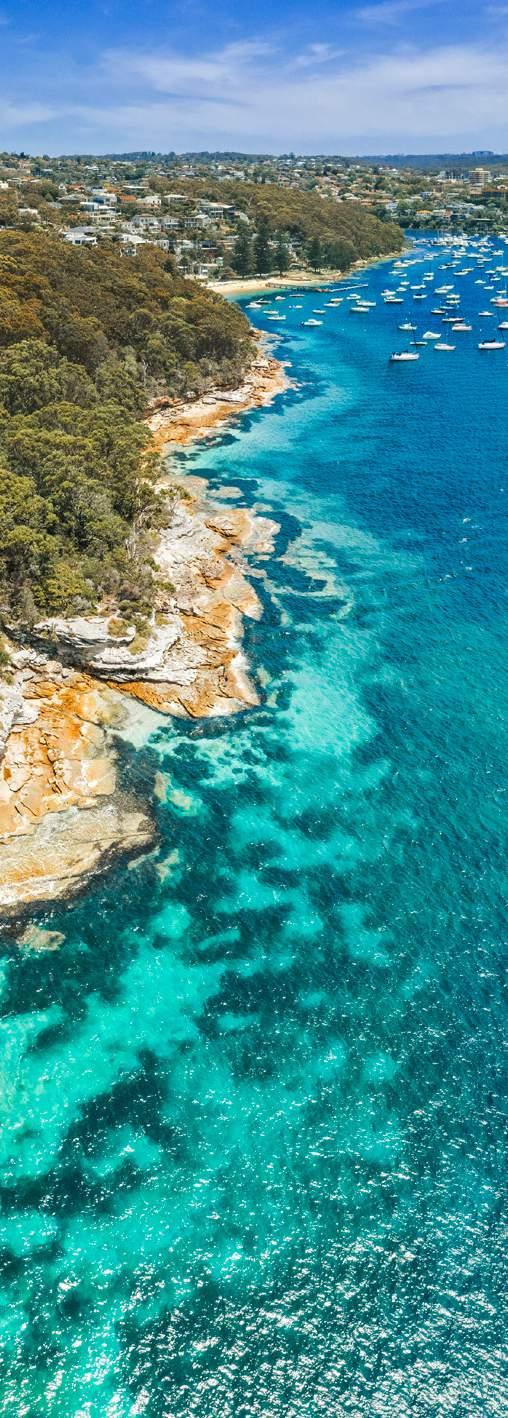
MELBOURNE
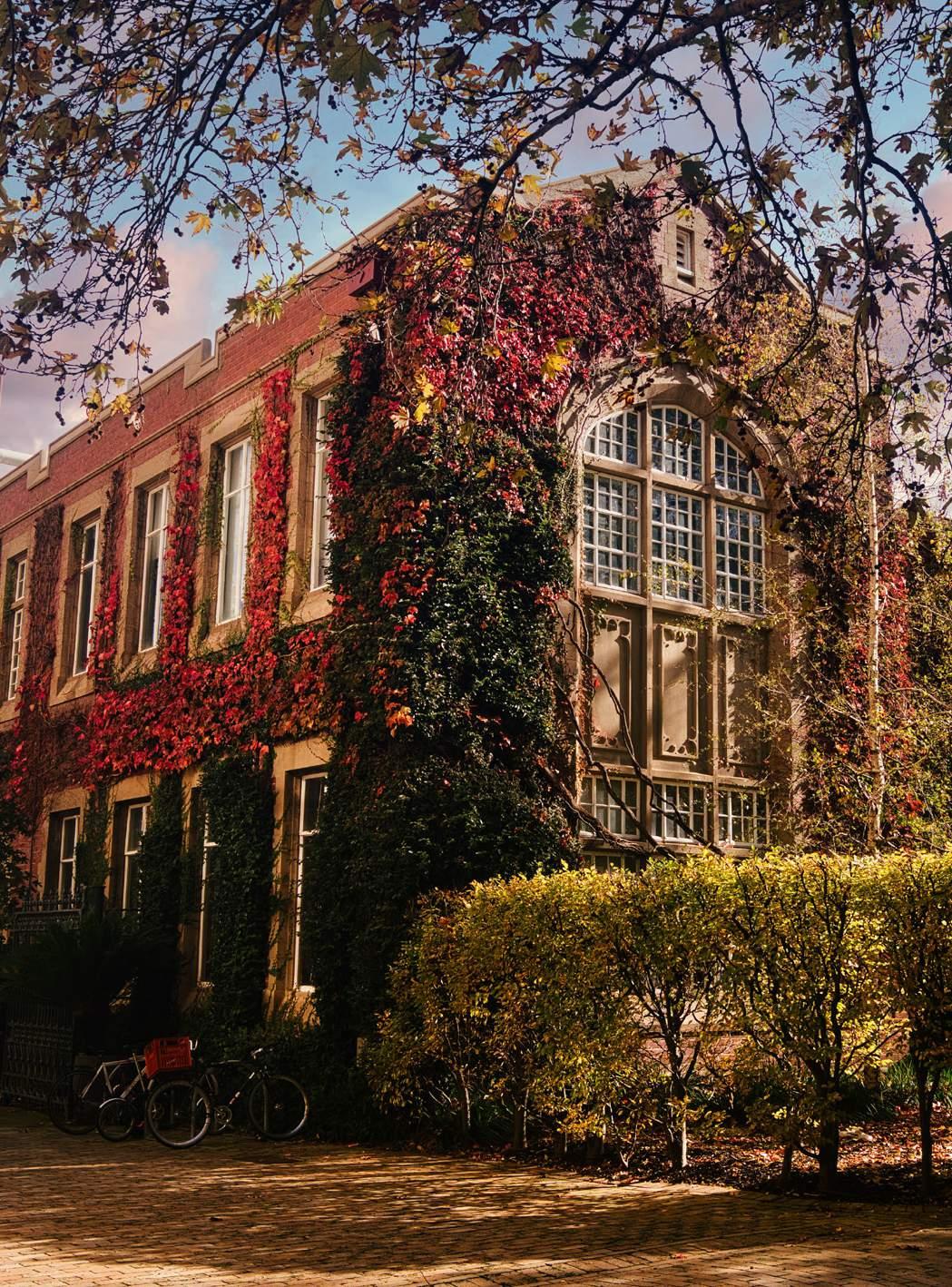
MELBOURNE
& SURROUNDS
MEDIAN HOUSE PRICE
$948,879
MEDIAN APARTMENT PRICE
$608,281
MELBOURNE SOARED WITH POST-PANDEMIC OPTIMISM IN THE OPENING MONTHS OF 2022.
Melbourne soared with post-pandemic optimism in the opening months of 2022 as it continued its strong comeback from Australia’s longest lockdowns.
The international border reopened in February 2022 to welcome many happy scenes of family reunions, while thousands of Australians rejoined the workforce to bring unemployment rates to new lows. International arrivals to Australia soared by 103,370 trips, and departures increased by 158,980 trips in March1
Vendors made up for lost time with an abundance of listed properties hitting the market. Melbourne’s advertised stock rose by 1.3% in 2021 and 8.1% above average in the previous five years2.
PROPERTY PRICES BEGAN TO STABILISE IN EARLY 2022 WITH VALUES RISING AT A MUCH SLOWER PACE THAN IN 2021.
In January and February of 2022, Melbourne’s median house prices had grown incrementally by 0.5%3 . By August 2022, Melbourne’s median house price was growing at an annual rate of just 0.2% to reach a median of $964,950. Unit prices were similar at 0.5% annual growth, with a median of $614,3514.
The softening growth can be attributed to various factors: less government stimulus with the reopening of businesses and interstate borders, reduced housing affordability owing to previous price surges, rising mortgage rates and a more conservative approach from financial lenders.
However, in what many have described as a ‘two speed market’, values in regional Victoria remained buoyant. By August, the median house price in regional Victoria had climbed 12.9% annually to reach $627,942, while unit prices lifted by 11.2% to sit at a median of $416,5305.
This price growth in regional Victoria is expected to ease with more interest rate rises tipped to come. Some towns may be insulated from this cooling effect in the short term due to relative buyer demand, while larger regional centres such as Geelong and Ballarat recorded declines in home values over the three months to July6.
MELBOURNE IS PULLING OUT ALL THE STOPS TO REINVIGORATE ITS CBD IN THE WAKE OF THE PANDEMIC.
Highlights include the $1.7 billion transformation of the arts precinct in Southbank 7, a proposed High Line-style revitalisation of the banks of the Yarra River, expected to inject $1 billion into the economy 8 , and the completion of five new train stations as part of the Metro Tunnel project due to be completed in 20259.
Geelong, the state’s most populous regional town, has continued to benefit from a 10-year plan for revitalisation. Having begun in 2019, the plan will see the Australian and Victorian Governments, together with the City of Greater Geelong, deliver $502.48 million in investment to the town.
Projects either completed or underway include the redevelopment of the Geelong train station, the construction of the Queenscliff Ferry Terminal and the redevelopment of the Twelve Apostles precinct10.
When looking at the demographics of buyers, the story is mixed. Victorian first home buyers are especially active in new housing markets, representing 45% of all home buyers in new developments in the state. But that is expected to drop off as strong building demand and materials shortages push up construction costs11.
In terms of loans, their numbers have already dropped off with housing loan data from the Australian Bureau of Statistics (ABS) showing 3,496 loans dispensed in January 2022 to first home buyers compared with 3,014 in June. The number of loans to owner occupiers rose from 9,805 in January to 11,137 in June, as did loans to investors, from 4,333 in January to 5,896 in June12.
The number of foreign buyers in Victoria’s established housing market rose from 3.1% of the market in the 2021 December quarter to 5.1% in the 2022 June quarter 13 .
A STRONGER THAN EXPECTED COMEBACK FROM COVID-19 PROPELLED MELBOURNE
THROUGH 2021, BUT THAT COMEBACK HAS LOST MOMENTUM.
Melbourne’s housing market is expected to keep cooling this year as interest rates are tipped to keep rising. But experts say this should be viewed alongside a strong economy and unemployment, which means that most households will be able to adapt to this new normal14.
JOHN M c GRATH’S
TOP PICKS
CROYDON SOUTH
This suburb is popular for its parks and quiet streets, as well as its easy access to Eastland Shopping Centre and the Eastern Freeway, which takes you to either the CBD or the Mornington Peninsula. The council and State Government have invested in the suburb as a pilot 20-minute neighbourhood, where they want to make it easier for residents to get around locally on foot or by bike. Works have included the creation of temporary cycling lanes and pop-up play areas.
NORTH MELBOURNE
This inner city suburb has been slowly gentrifying over the years and now boasts a vibrant arts and restaurant scene. It has wide streets for somewhere so close to the CBD (three kilometres away), with period homes in amongst the renovated warehouses and apartment blocks. You can walk to the city, or nearby Queen Victoria Market, and when Arden station opens as part of the new Metro Tunnel it will only increase residents’ ability to get to other parts of Melbourne.
LALOR
Popular with families for its big blocks, abundance of schools and a choice of sporting clubs, Lalor is one of a handful of suburbs in Melbourne where houses are still selling for less than $800,000. The suburb is serviced by the Northern Hospital, two universities in nearby Bundoora — RMIT and LaTrobe — as well as shops in neighbouring Epping. The State Government and council are investing more than $2 million in a revitalisation program to fund streetscape improvements and new public spaces1 .




HEIDELBERG HEIGHTS
Just 16km from the city, Heidelberg Heights has flown under the radar for years as a bridesmaid suburb to its more expensive neighbour, Ivanhoe. Older housing stock is gradually being replaced by new houses and apartments. Its population is culturally diverse and there’s a variety of families, young professionals and retirees who have lived here for decades. It is serviced by the Heidelberg train station, Austin Hospital and five bus lines.
POINT LONSDALE — REGIONAL VICTORIA
Seachangers flock to Point Lonsdale, not only for its village-by-the-seaside vibe, but also its growing cafe, winery and restaurant scene. Its population is a mix of retirees, young families and hipsters who all enjoy the beach lifestyle. Unlike its neighbour Queenscliff, Point Lonsdale occupies a larger area and there is more housing stock to choose from.






BRISBANE
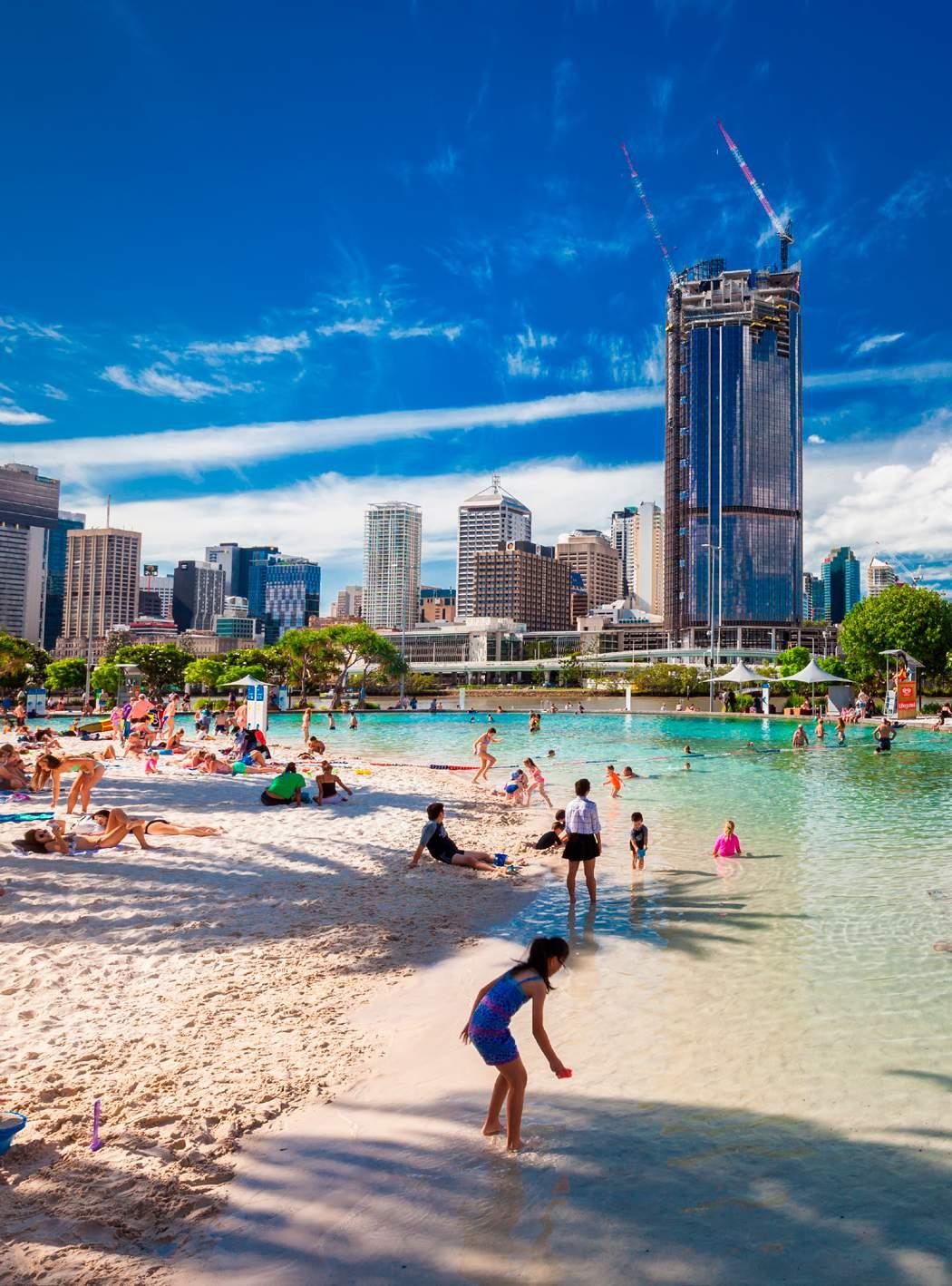
BRISBANE & SURROUNDS
MEDIAN HOUSE PRICE
$864,149
MEDIAN APARTMENT PRICE
$501,396
THE PROPERTY MARKET IN SOUTH EAST QUEENSLAND MIGHT BE COOLING, BUT LIKE THE LOCAL CLIMATE, EXPERTS SAY IT WON’T BE CHILLY FOR LONG1. THE REGION IS TIPPED TO HELP LEAD THE NATIONAL RECOVERY, WITH MAJOR INFRASTRUCTURE PROJECTS AND STEADY POPULATION GROWTH IN THE YEARS AHEAD.
Figures indicate that home prices are correcting after a period of record growth. Median dwelling values in Brisbane fell — 0.8% in July, while for the three months to August they increased 0.1%, and in the previous 12 months 22.1%2. Homes listed for sale are also spending more time on the market — another indication that the urgency and buyers’ fear of missing out is waning.
While property values in most parts of the Sunshine Coast, for example, have continued in an upwards trajectory, the gains are lower than 12 months ago. Sunrise Beach’s median house price increased 0.4% in the three months to June 20223 , but property prices in nearby Ilkley, Tanawha and Minyama all dropped over the same period4.
SOUTH EAST QUEENSLAND, HOWEVER, REMAINS MORE BUOYANT THAN MANY PARTS OF THE COUNTRY.
This market stability is driven by several factors, including continued interstate migration, limited housing supply and the 2032 Olympics and associated infrastructure being developed across the region.
There is still a steady stream of interstate buyers lining up to purchase their piece of paradise, with federal budget figures estimating 41,000 people moved to Queensland during FY225. Fuelled by the work from home era and the lure of a better work/ life balance, this figure is expected to remain steady through to 2024 when migration rates will return to those of pre-COVID times.
The trend will not reverse though, and the state’s population is expected to grow by 298,000 by 20266.
The state continued to have the country’s most popular regional areas, with the Gold Coast welcoming 11% of all seachangers from capital cities during 2021. The Sunshine Coast was the next most popular, taking in 5%7
Lack of supply continues to underpin the Gold Coast market, where affordable housing options are dwindling8. This is set to be exacerbated by the collapse of several notable developers in the region9.
The Brisbane 2032 Olympic and Paralympic Games is another factor that will underpin the market across the state’s south east. It already has paved the way for a number of road and rail upgrades and other infrastructure projects in the region, which will help to ensure it is well equipped for a population boost.
THE BRISBANE 2032
OLYMPIC AND PARALYMPIC
GAMES IS ANOTHER FACTOR THAT WILL UNDERPIN THE MARKET.
Amongst them is the $1.8 billion South East Queensland City Deal, funded by all three levels of government, which will begin a 20-year pipeline of infrastructure projects across the region10
The long-delayed $1.6 billion Brisbane to Sunshine Coast passenger rail line will revolutionise public transport from the capital city to the Sunshine Coast’s pristine beaches. Improved travel times have also been promised to southern commuters, with $1.12 billion being invested to create faster rail services between the Gold Coast and Brisbane.
WHILE HOUSE VALUE GROWTH HAS SLOWED ACROSS THE SOUTH EAST, RENTS CONTINUE TO RISE SWIFTLY.
House rents in the suburb of Ormiston, near Redland Bay on the outskirts of Brisbane, have increased by 25%, while on the Gold Coast at Paradise Point, rents have jumped 45.5% in the 12 months to June 202211.
Demand for high density rental properties is also increasing largely due to a lack of house rentals and increasing asking rents.
Overall, the slowdown in price growth in Queensland’s south east will give buyers their best chance to get into the market, while remaining confident that infrastructure spending and population growth will keep prices buoyant relative to other parts of the country for some time to come.
JOHN M c GRATH’S
TOP PICKS
NEW FARM – BRISBANE
Cars are optional in this popular inner northern, riverside suburb located an easy walk from the CBD. Famed for its namesake park, sprawling Queenslander homes and relaxed dining, it has long been favoured by professionals and families.
Prices for both houses and apartments aren’t as bullish as they were at the end of 20212, potentially offering an entry point to this prestigious postcode.
WOOLLOONGABBA – BRISBANE
Neighbouring Brisbane’s CBD, Woolloongabba has a mix of families and professionals1 thanks to its growing restaurant and nightlife scene, proximity to great schools, the city and the iconic Gabba stadium. The inner city suburb, which is dotted with renovated Queenslanders and modern apartments, is one to watch thanks to its central location for the 2032 Brisbane Olympics.
KANGAROO POINT – BRISBANE
One of Brisbane’s oldest suburbs and Queensland’s first penal settlement, Kangaroo Point is rich in history and character. Perhaps the jewel in the suburb’s heritage crown is the sprawling 1800s mansion aptly named ‘Home’, which was sold in 2021. A momentary dip in property prices in the picturesque riverside suburb could be an opportunity for savvy buyers.

PALM BEACH — GOLD COAST
Like most Gold Coast suburbs, Palm Beach has experienced considerable price gains over the past few years. The proposed light rail continues to ruffle the feathers of some locals. But there is no arguing the planned infrastructure is fuelling the area’s growth, with the cranes of residential and commercial developments dotting the skyline of the beachside suburb. ‘Palmy’ (as it’s affectionately known) is one to watch.
CALOUNDRA — SUNSHINE COAST
Famed for its beautiful beaches, picturesque walkways and fishing spots, the southern-most Sunshine Coast suburb is a haven for tourists. Planned infrastructure is also making it a popular choice for property investors. The proposed $1.6 billion passenger rail line will not only improve connectivity with Brisbane, it will also see the redevelopment of the area’s urban centre around the new railway station to cater for the population growth. There are a number of upcoming projects aimed at reshaping Caloundra, including a new $110 million apartment development and a boutique hotel and apartment complex.
CANBERRA

CANBERRA
MEDIAN HOUSE PRICE
$1,033,377
MEDIAN APARTMENT PRICE
$615,560
Canberra house prices crossed the $1 million median for the first time in FY22, with dwelling values across the city almost 40% higher than pre-pandemic levels by the end of the year1 .
THREE YEARS OF CONSISTENT GROWTH HAS LED TO CANBERRA DECOUPLING FROM THE SMALLER CAPITAL CITIES TO JOIN SYDNEY AND MELBOURNE AS AUSTRALIA’S MOST VALUABLE PROPERTY MARKETS.
This makes the nation’s capital exceptionally well-placed to weather the economic challenges ahead. Its median house price by the end of FY22 was $1,065,3172
With significant new wealth amongst homeowners, and locals earning Australia’s highest average incomes3, Canberrans are well equipped financially to cope with rising inflation and interest rates.
Unlike Sydney and Melbourne, median apartment values in Canberra also soared in FY22, up 18.3% to $629,5311 . This was largely a result of record demand from first home buyers — with loans in 2021 up 64% on 2019, according to the Australian Bureau of Statistics (ABS)4 — and investors, amid a growing undersupply.
The undersupply might seem surprising given the large amount of medium-density residential development occurring in the nation’s capital. The city is adopting apartment living at scale for the first time, as its population growth becomes too great and land supply too limited to allow continuing urban sprawl. But much of this new stock is designed for downsizers. The challenge for first home buyers is to navigate the fierce competition for a low supply of smaller one and two bedroom apartments.
Many Canberra homeowners are choosing to reinvest their new equity in local property. ABS data shows there has never been more money borrowed per annum to buy or renovate investment properties in Canberra than in 20215.
Scores of parents are motivated to buy investment apartments to give their children a home whilst studying at university amid the rental shortage. With the city’s vacancy rate at 1.1%6, landlords are earning the highest median weekly rents ($690) of all the capital cities and rents are still growing7. Returning international students are adding more competition to the market.
ALTHOUGH CANBERRA HOME VALUES HAVE RISEN EXPONENTIALLY, THERE IS STILL MUCH OPPORTUNITY FOR FUTURE GROWTH.
Although Canberra home values have risen exponentially, there is still much opportunity for future growth, which is another factor fuelling buyer sentiment.
KEY RETAIL AND JOB DISTRICTS SUCH AS GUNGAHLIN AND BELCONNEN ARE BUZZING WITH MAJOR INFRASTRUCTURE PROJECTS ALL DESIGNED TO ENHANCE LIVEABILITY.
A key example is the masterplanned redevelopment of Belconnen Town Centre, which is causing a ripple effect through surrounding suburbs. Young families wanting to live close to impressive new amenities are purchasing older houses to renovate or rebuild. Their budgets stretch further in the north, with older houses starting at about $1 million.
Suburbs in the north don’t carry the sometimes hefty price tags of the city’s older southern suburbs, but that is why there is more upside for home values.
Canberra has an excellent economy, it’s easy to get around, and Sydney and Melbourne are more accessible via the upgraded M31. Its proximity to the south coast and snowfields makes it ideal for those people valuing more holiday-at-home options in the COVID-19 era.
With supply of homes for sale increasingly limited, Canberra is likely to consolidate its price gains in FY23, with fewer transactions expected as people stay put and watch how the economy copes with the first rising interest rate cycle in more than a decade.
JOHN M c GRATH’S
TOP PICKS
O’CONNOR
Bordering lush bushland on the edge of the CBD in Canberra’s desirable inner north, O’Connor shone during COVID-19, with upgraders from all over the city recognising the value of its unique bush/city lifestyle and adored local village. O’Connor is gentrifying as nature-lovers buy 1950s knockdowns to build architecturally significant, energy efficient homes that pay homage to the beautiful natural surroundings. Generous blocks of 850-1,000 sqm allow for extras like pools and backyard studios used as home offices.
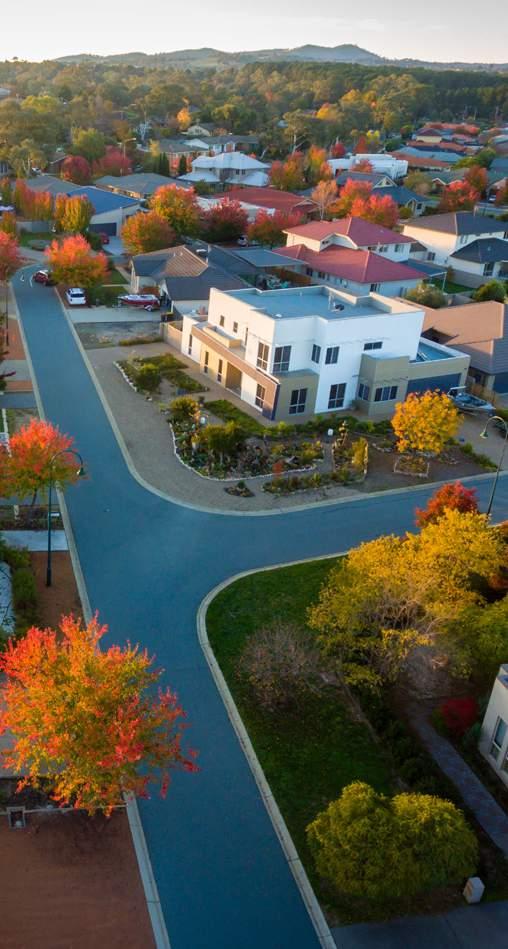

DENMAN PROSPECT
This high quality developing suburb in the Molonglo Valley is one of the few suburbs left offering vacant blocks and is being developed by local billionaire, Terry Snow, whose family company built Canberra Airport. Snow is known for his highly curated developments and unique placemaking attitude as a proud Canberran. As a result, Denman Prospect is being built to meticulous standards with lots of sustainability practices. It is Australia’s first suburb with minimum solar power requirements for every home and it has a blossoming town centre.
FORDE
This popular suburb offers a quiet life within a tightknit and friendly multicultural neighbourhood. Privately developed 14 years ago, it was initially known for its popularity with young families. Today, it’s full of high quality homes and lots of green space. Adjoining Mulligans Flat Nature Reserve, there are numerous walking trails and it’s not uncommon to see kangaroos hopping through front yards.
BELCONNEN TOWN CENTRE
Home to a major Westfield and several Federal Government departments, the redevelopment of Belconnen Town Centre under a masterplan released in 2016 is well underway, transforming it into a contemporary lakeside community and commercial hub. The plan incorporates outdoor dining at Emu Bank, land release and development around Lake Ginninderra, walking and bicycle paths, improved landscaping and high quality residential apartments. The ever popular Belconnen Markets is being repurposed into a European market hall called Capital Food Market, opening in 2023.
WODEN TOWN CENTRE
Woden Town Centre in south Canberra is buzzing as it transitions from old to new and cool. Luxury apartment towers and lifestyle retail precincts are replacing rundown commercial buildings. Examples include The Shard and The Melrose, which will have spacious designer one, two and three bedroom abodes with high-end finishes. Woden Town Centre will be included in the approved second stage of the light rail network.

HOBART
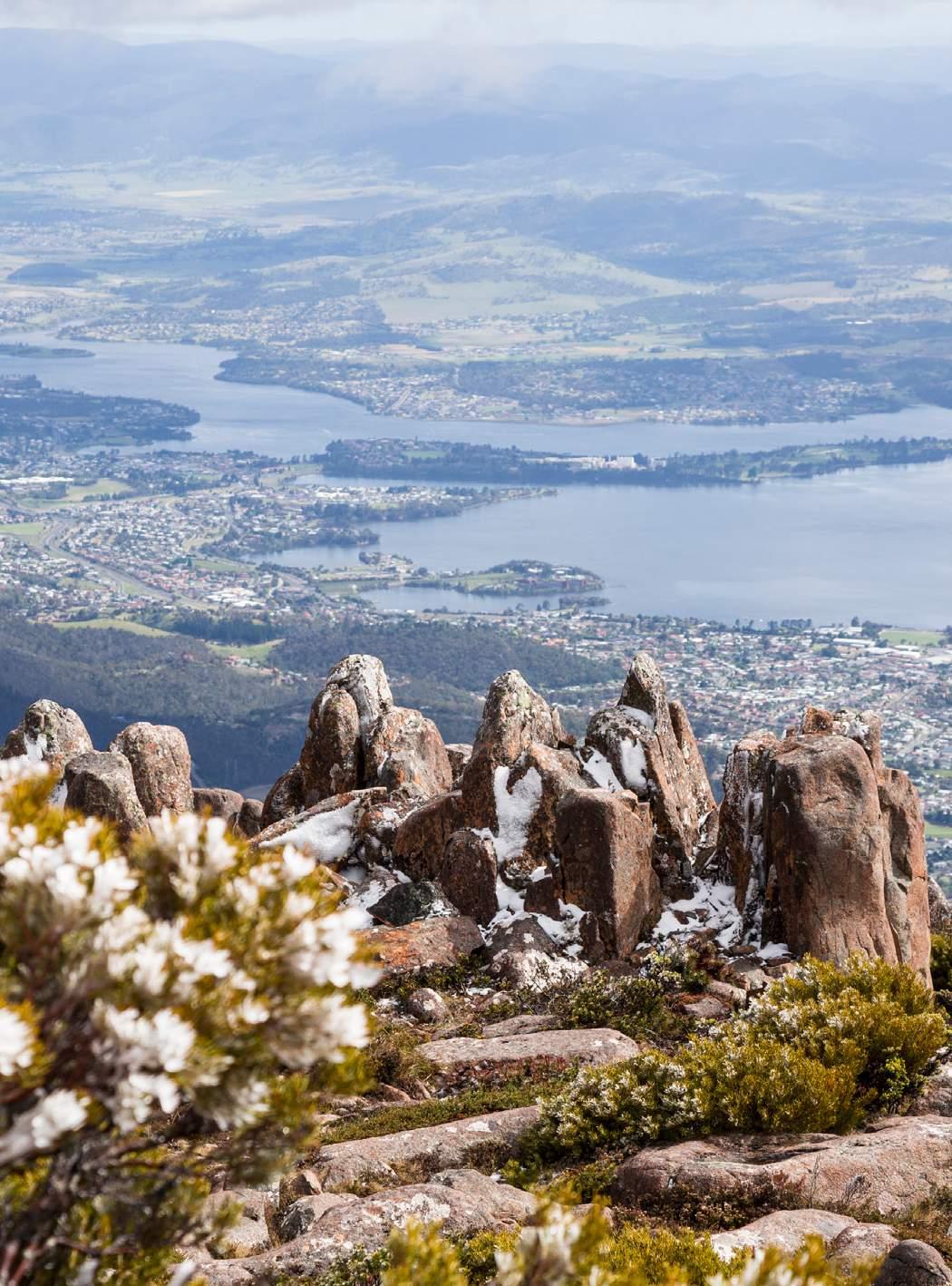
HOBART & SURROUNDS
MEDIAN HOUSE PRICE
$772,443
MEDIAN APARTMENT PRICE
$574,866
TASMANIA’S HEADY COMBINATION OF WILD, UNSPOILT BEAUTY AND A REPUTATION FOR FINE FOOD, WINE AND THE ARTS PROVIDES THE PERFECT TONIC FOR HOLIDAY MAKERS LOOKING FOR A PERMANENT GETAWAY.
The Apple Isle has leveraged this unique lifestyle most recently by urging visitors to “come down for air”1 and experience the Tasmania difference.
A decade of prosperity 2 followed the 2011 opening of the Museum of Old and New Art (MONA) and after emerging from COVID-19 restrictions on December 15, 2021, the State Government’s fiscal and monetary support3 solidified Tasmania’s position as the country’s best performing economy4
In property terms, Hobart achieved 22 consecutive months of growth in dwelling values that came to an end in April 20225 , as rising stock levels and the prospect of higher interest rates put downward pressure on prices6.
During that period, median dwelling values increased by 17.3% in the 12 months to the end of May 2022, with houses rising 17% to a median of $796,595, and apartments rising 18.6% to a median of $590,0747.
But even that was surpassed by the runaway results of regional Tasmania where dwelling values increased 25.4%8 over the same period.
Affordability, lifestyle and much improved economic conditions9 have helped fuel buyer demand, resulting in an impressive five-year run for Hobart and the highest growth in median house prices of any capital city — increasing 93.5% between 2017 and 202210. In the past two years alone the number of suburbs with a median price of $1 million or more went from two11 (Battery Point and Sandy Bay) in 2020 to 10 in 202212.
However, conditions may be starting to shift, with Hobart dwelling values declining in April 2022 for the first time since July 2020.
Total listings volumes started to accumulate across Hobart in May, and typical days on market have risen from eight days in late 2021, to 25 days in May 13 .
The sustained growth has reduced affordability, particularly for first home buyers, with fewer of these borrowers taking on mortgages month-on-month in 202214. The trend in building rather than purchasing an existing property15 is helping fuel high growth areas of Greater Hobart such as Rokeby, Howrah-Tranmere and the township of Brighton.
A 7.9% annual increase in weekly house rents to the end of July 202216 in Hobart — up 63% over the decade to a citywide median of $561 a week 17 — confirms the state’s severe dwelling shortage. It’s a situation the state government is attempting to resolve, announcing $1.5 billion18 to deliver 10,000 new homes over the next decade.
RETURNS OF DOMESTIC AND INTERNATIONAL TOURISTS AND STUDENTS IS A POSITIVE ECONOMIC DRIVER PARTICULARLY FOR HOSPITALITY AND TOURISM OPERATORS 19 . THIS WILL ALSO BOOST MIGRATION LEVELS AND RETURN THE STATE’S POPULATION GROWTH CLOSER TO PRE-PANDEMIC LEVELS20.
The expected return to net positive population growth will also place additional demand on dwelling supply, requiring private investments and future housing development21.
While the state may have lost some momentum in the first half of 202222, several fundamentals such as strong relative annual population growth 23 , increasing wages24 and low unemployment levels25 are tipped to help stabilise the Tasmanian economy, with the forecast of pre-pandemic growth levels returning in 2023-2426.
These fundamentals will help ensure Tasmania’s property market remains in good stead for the foreseeable future.
AT THE HEIGHT OF COVID-19, LAUNCESTON WAS ONE OF THE MOST POPULAR DESTINATIONS FOR
THOSE MIGRATING FROM OTHER AUSTRALIAN CITIES.
AS TASMANIA’S SECOND LARGEST CITY, LAUNCESTON HAS ITS OWN UNIQUE DELIGHTS, INCREDIBLE PRODUCE AND AN EVENTS CALENDAR TO RIVAL HOBART, WITH MAJOR SPORTING CARNIVALS, ART EXHIBITIONS AND FESTIVALS 1 .
And at the height of COVID-19, it was one of the most popular destinations for those migrating from other Australian cities2.
Compared with Hobart, Launceston’s relatively affordable property prices have certainly been one compelling reason for buyers. Its median house value was $581,9273 as at July, 2022, while Hobart’s was $782,748 for the same period4
Affordability has also driven Launceston’s apartment market, with 42.7% of all sales in the 12 months to July 2022 priced between $200,000 and $400,0005. As a result, it’s one of the strongest regional apartment markets in the country, with stock selling quicker than anywhere else with a median days on market of 13 days and annual growth of 20% over the year to July 2022. The region has outperformed even the perennially popular South East Queensland holiday destination of the Sunshine Coast6.
The future looks bright for the city of 68,000 people, which is midway through the Launceston City Deal7, a $536 million, 10-year8 plan. Designed to boost jobs and attract business investment, the deal aims to create one of Australia’s most liveable and innovative regional cities.
JOHN M c GRATH’S
TOP PICKS
SANDY BAY — HOBART
The inner city suburb of Sandy Bay has long been revered for its convenience, amenity and natural beauty. Panoramic water views, prestigious schools and a mix of historical and modern mansions have made it a magnet for the well-heeled. But it also has another side — student-friendly apartments and a vibrant restaurant scene that caters to all budgets. If sailing at The Royal Yacht Club of Tasmania isn’t your thing, there’s always a stroll along the waterfront footpaths into the CBD.
KINGSTON BEACH — HOBART
It’s hard to believe Kingston Beach median property prices only recently broke $1 million1 . The popular lifestyle destination, 15 minutes south of the Hobart CBD, is abuzz most mornings with ocean swimmers, runners heading to the Alum Cliffs trail and dog walkers hitting the sand. There’s an idyllic 18 holes at Kingston Beach Golf Club, a redesigned 1970s beachfront pub, a hip cocktail bar, and the line for coffee at Ebb & Flo is worth it.



ST LEONARDS — LAUNCESTON
New land subdivisions have maintained St Leonards’ semi-rural character and views of the valley, city and mountains. And buyers are voting with their feet. They’ve been snapping up property here in a little over a week2, drawn by the wide open spaces, convenient 10 minute drive into the CBD and quality schools.
INVERMAY — LAUNCESTON
Invermay’s future as a cultural, educational and recreational hub is well on its way. The suburb is within walking distance of the popular AFL turf of UTAS Stadium and less than five minutes from Launceston’s CBD. The first building of the new University of Tasmania Inveresk campus has opened with two more under construction3 . Families are being drawn to the popular Riverbend Park children’s playgrounds, while buyers are falling in love with its many character homes.
DEVONPORT — REGIONAL TASMANIA
Devonport’s urban renewal plan4 — the largest of its kind in regional Tasmania — is helping to future-proof its status as the northwest’s tourism gateway and bring in serious investment dollars for the redevelopment of Port Devonport, new parklands, housing subdivisions and accommodation. Aside from better amenities, the city offers many outdoor activities, such as cycling, kayaking or bushwalking nearby Cradle Mountain National Park.
HAS COVID-19 REDESIGNED THE HOME?
1. The Great Stink - How the Victorians transformed London to solve the problem of Waste, Historic England, https://historicengland.org.uk/images-books/archive/collections/photographs/ the-great-stink/
2. Re-Thinking Post Pandemic Home Design: How Covid-19 Affected the Perception and Use of Residential Balconies in Egypt, Zeina ElZein and Yasmin ElSemary, Future Cities and Environment, published February 16, 2022, https://futurecitiesandenvironment.com/articles/10.5334/fce.140/
3. Nearly a third of Australians have been ‘#WFH’, Finding no. 8451, Roy Morgan, published June 29, 2020, http://www.roymorgan.com/findings/8451-roy-morgan-working-from-homejune-2020-202006290638
4. More than 40 per cent of Australians worked from home, Australian Bureau of Statistics, published December 14, 2021, https://www.abs.gov.au/media-centre/media-releases/ more-40-cent-australians-worked-home
5. What’s most important to Aussies when they buy a home, NAB News, published February 3, 2022, https://news.nab.com.au/news/whats-most-important-to-aussies-when-they-buy-a-home/
6. WFH forever? Two years into a work-from-home revolution, some may never return to the office, by Daniel Ziffer, ABC News, published April 4, 2022, https://www.abc.net.au/news/2022-04-04/ wfh-forever-two-years-on-some-workers-will-never-go-back-to-the-/100949678
7. Four bedrooms... four bathrooms? How COVID-19 is changing home design, James Purtill, ABC News, published May 20, 2022, https://www.abc.net.au/news/science/2022-05-20/ covid-19-pandemic-home-house-design-how-it-is-changing/101077024
8. Open floor plan: History, pros and cons, Lee Wallender, The Spruce, published March 1, 2022, https://www.thespruce.com/what-is-an-open-floor-plan-1821962
9. Now what? How home design and architecture should adapt to a post-COVID world, Charles Curkin, Elle Décor, published January 7, 2021, https://www.elledecor.com/design-decorate/ interior-designers/a34918038/architecture-home-design-after-covid-pandemic/
10. Aussies skipping holidays and spending at home in 2021, Alex Ritchie, RateCity published June 17, 2021, https://www.ratecity.com.au/home-loans/mortgage-news/aussies-skipping-holidays-spending-home-2021
11. How the pandemic changed our concept of home and how we use our spaces, Marissa Hermanson, Washington Post, published April 6, 2022, https://www.washingtonpost.com/magazine/2022/04/06/ pandemic-home-design/
12. 4 ways COVID has changed home design, Blake Morgan, Forbes, published September 28, 2020, https://www.forbes.com/sites/blakemorgan/2020/09/28/4-ways-covid-has-changed-homedesign/?sh=7d2310956843
13. COVID-19 is driving a boom in demand for alternative swimming pools as people reinvest in their homes, Keely Johnson, ABC News, published December 26, 2021, https://www.abc.net.au/ news/2021-12-26/covid-19-sparks-boom-in-demand-for-alternative-swimming-pools/100694982
14. 6 ways COVID-19 will change home design, Nathan Bahadursingh, Architizer, https://architizer.com/blog/inspiration/industry/covid-19-home-design/
15. How many pets are there in Australia? RSPCA, published March 6, 2020, https://kb.rspca.org.au/ knowledge-base/how-many-pets-are-there-in-australia/
16. Barkitecture: Unleash your home design, Pinterest Predicts 2022, https://business.pinterest. com/en-au/pinterest-predicts/2022/barkitecture/
17. Methven key bathroom trends 2022, Jessie Warner, The Kitchen and Bathroom Blog, published March 16, 2022, https://thekitchenandbathroomblog.com.au/2022/03/16/methven-keybathroom-trends-in-2022/
IS AUSTRALIA’S PLACE IN THE SUN SET TO RISE?
1. The Economic, Social and Cultural Impacts of Migration in Australia, Australian Parliament Joint Standing Committee on Migration Submission No. 111, published April 2011, https://www.aph.gov. au/parliamentary_business/committees/house_of_representatives_committees?url=mig/ multiculturalism/subs/sub111.pdf
2. 2022-23 Budget: Australia’s Future Population, Australian Government Centre for Population, published March 2022, https://population.gov.au/sites/population.gov.au/ files/2022-04/2022-23_budget_overview.pdf
3. Knight Frank Global Buyer Survey 2021, published August 25, 2021, https://content.knightfrank. com/research/2039/documents/en/global-buyer-survey-2021-8382.pdf
4. The return of overseas arrivals and Australia’s property market, CoreLogic, published February 6, 2022, https://www.corelogic.com.au/news-research/news/archive/the-return-of-overseas-arrivalsand-australias-property-market
5. 2022-23 Budget: Australia’s Future Population, Australian Government Centre for Population, published March 2022, https://population.gov.au/sites/population.gov.au/files/2022-04/2022-23_ budget_overview.pdf
6. The return of overseas arrivals and Australia’s property market, CoreLogic, published February 6, 2022, https://www.corelogic.com.au/news-research/news/archive/the-return-of-overseas-arrivals-andaustralias-property-market
7. CoreLogic Market Chat, Rental Market Update, published May 2022
8. NAB Residential Property Survey Q2 2022, NAB, published June 30, 2022, https://business.nab.com.au/wp-content/uploads/2022/06/NAB-RESIDENTIAL-PROPERTYSURVEY-Q2-2022.pdf
9. Emailed responses to interview questions put to CoreLogic Research Director Tim Lawless, June 7, 2022
10. Foreign Investment Review Board Annual Report 2020-21, published April 2022, https://firb.gov.au/sites/firb.gov.au/files/2022-04/FIRB-Annual-Report-2020-21.pdf
11. NAB Residential Property Survey Q2 2022, NAB, published June 30, 2022, https://business.nab.com.au/wp-content/uploads/2022/06/NAB-RESIDENTIAL-PROPERTYSURVEY-Q2-2022.pdf
12. Foreign Investment Review Board Annual Report 2020-21, published April 2022, https://firb.gov.au/sites/firb.gov.au/files/2022-04/FIRB-Annual-Report-2020-21.pdf
13. Phone interview with SQM Research founder and managing director Louis Christopher, June 8, 2022
14. Property’s time in the sun: What investors need to know, altx.com.au, published March 23, 2022, https://www.altx.com.au/media/article-bernard-salt-and-propertys-time-in-the-sun-whatinvestors-need-to-know/
15. Snapshot of Australia 2021, Australian Bureau of Statistics, published June 28, 2022, https://www.abs.gov.au/statistics/people/people-and-communities/snapshot-australia/2021
16. Where do Migrants Live? Australian Bureau of Statistics, published March 18, 2014, https://www.abs.gov.au/ausstats/abs@.nsf/Lookup/4102.0main+features102014
17. 2016 Census Quick Stats: Australia, Australian Bureau of Statistics, https://www.abs.gov.au/ census/find-census-data/search-by-area
FRINGE BENEFITS: WHY YOUR NEIGHBOURING SUBURB COULD BE A BETTER BUY
1-8. Mapping the Market - April 2022, CoreLogic, https://www.corelogic.com.au/our-data/mapping-market
9-11. Mapping the Market - July 2022, CoreLogic, https://www.corelogic.com.au/our-data/mapping-market
FROM THE BEACH TO THE BUSH: ARE WE SEEING A POSTCODE SHIFT?
1. Regional Population, Australian Bureau of Statistics, published March 29, 2022, https://www.abs.gov.au/statistics/people/population/regional-population/2020-21
2. Regional Movers Index December 2021 Quarter Report, Regional Institute Australia, no publication date, https://www.commbank.com.au/content/dam/caas/newsroom/docs/ Regional_Movers_Index_December_2021.pdf
3. Population growth and mobility in Australia: implications for housing and urban development policies, Australian Housing and Urban Research Institute, published October 2021, https://www.ahuri.edu.au/sites/default/files/documents/2021-10/AHURI-Final-Report-365Population-growth-and-mobility-in-Australia.pdf
4. More growth in the regions during the pandemic, Australian Bureau of Statistics, published March 29, 2022, https://www.abs.gov.au/media-centre/media-releases/more-growth-regions-during-pandemic
5. More growth in the regions during the pandemic, Australian Bureau of Statistics, published March 29, 2022, https://www.abs.gov.au/media-centre/media-releases/more-growth-regions-during-pandemic
6. New data demonstrates how Australia’s population growth is responding to the pandemic, SGS Economics and Planning, published March 31, 2022, https://www.sgsep.com.au/publications/insights/ new-data-demonstrates-how-australias-population-growth-is-responding-to-the-pandemic
7. Regional job vacancies remain steady at 84,600, Regional Institute Australia, published May 30, 2022, https://regionalaustralia.org.au/Web/Web/Toolkits-Indexes/Regional-JobsUpdate/Updates/2022/REGIONAL-JOB-VACANCIES-REMAIN-STEADY-AT-84-600-.aspx
8. Rural Victoria Housing Blueprint, SGS Economics and Planning, published December 4, 2021, https://media.ruralcouncilsvictoria.org.au/wp-content/uploads/2021/12/06122347/20210351RCV-Housing-Blueprint-FINAL-211201-WEB.pdf
9. Hedonic Home Value Index, CoreLogic, published August 1, 2022, https://www.corelogic.com. au/__data/assets/pdf_file/0013/11812/CoreLogic-home-value-index-August22-FINAL.pdf
10. Heat starting to leave Regional Australia, but home values still on the rise, CoreLogic, published May 17, 2022, https://www.corelogic.com.au/news-research/news/2022/heat-starting-to-leaveregional-australia,-but-home-values-still-on-the-rise
11. Market Trends, 12 months to May 31, 2022, CoreLogic, published August 10, 2022
12. Hedonic Home Value Index, July 2022 Results, CoreLogic, published August 1, 2022, https://www.corelogic.com.au/__data/assets/pdf_file/0013/11812/CoreLogic-home-value-indexAugust22-FINAL.pdf
13. Market Trends, 12 months to May 31, 2022, CoreLogic, published August 10, 2022
14. Heat starting to leave Regional Australia, but home values still on the rise, CoreLogic, published May 17, 2022, https://www.corelogic.com.au/news-research/news/2022/heat-starting-to-leaveregional-australia,-but-home-values-still-on-the-rise
15. Heat starting to leave Regional Australia, but home values still on the rise, CoreLogic, published May 17, 2022, https://www.corelogic.com.au/news-research/news/2022/heat-starting-to-leaveregional-australia,-but-home-values-still-on-the-rise
16. Heat starting to leave Regional Australia, but home values still on the rise, CoreLogic, published May 17, 2022, https://www.corelogic.com.au/news-research/news/2022/heat-starting-to-leaveregional-australia,-but-home-values-still-on-the-rise
CITY SPOTLIGHTS — SYDNEY & SURROUNDS
1. Hedonic Home Value Index, December Results, CoreLogic, published January 4, 2021, https://www.corelogic.com.au/__data/assets/pdf_file/0016/11428/CoreLogic-home-value-indexJan-2021-FINAL-1.pdf
2. Hedonic Home Value Index, December Results, CoreLogic, published January 4, 2022, https://www.corelogic.com.au/__data/assets/pdf_file/0008/11411/2101_CoreLogic_ homevalueindex_Jan42022_FINAL.pdf
3. Market Trends, 12 months to February 28, 2022, house price growth in suburbs with 50 or more sales per annum, CoreLogic, published May 10, 2022
4. Mapping the Market - April 2022, CoreLogic, https://www.corelogic.com.au/our-data/mapping-market
5. Market Trends, 12 months to May 31, 2022, Median house and apartment prices of $900,000 or less, excluding suburbs with unavailable median price data, CoreLogic, published August 10, 2022
6. National Housing Finance and Investment Corporation Investment Mandate Amendment (Price Cap Update) Direction 2022, Federal Register of Legislation, published April 9, 2022, https://www.legislation.gov.au/Details/F2022L00585
7. Opening doors for more first home buyers, NSW Budget 2022-23, Media Release, NSW Government, published June 21, 2022, https://www.budget.nsw.gov.au/sites/default/ files/2022-06/20220620_01_PERROTTET-KEAN-ROBERTS-Opening-doors-for-more-firsthome-buyers.pdf
8. Gap between Australia’s house and unit market hits record high, CoreLogic, published March 28, 2022, https://www.corelogic.com.au/news-research/news/archive/gap-betweenaustralias-house-and-unit-market-hits-record-high
9. Market Trends, 12 months to February 28, 2022, median house prices above $5 million, CoreLogic, published May 10, 2022
10. Western Parkland City Blueprint: Shifting the Fundamentals, wpca.sydney, published 2022, https://wpca.sydney/coordination/draft-blueprint-for-the-western-parkland-city/ what-is-the-role-of-the-western-parkland-city-authority/
11. Western Parkland City Draft Blueprint, NSW Government, published December 2021, https://wpca.sydney/assets/Documents/Publications/Blueprint-and-EDR/WPCA_draft_Blueprint.pdf
12. Increasing urban tree canopy cover and delivering green grid connections, Greater Cities Commission, webpage as at June 4, 2022, https://greatercities.au/western-city-district-plan/ sustainability/city-its-landscape/increasing-urban-tree-canopy-cover-and
13. Market Trends, 12 months to May 2022, CoreLogic, published August 10, 2022
CITY SPOTLIGHTS — MELBOURNE & SURROUNDS
1. Overseas Arrivals and Departures, Australian Bureau of Statistics, published May 12, 2022, https://www.abs.gov.au/statistics/industry/tourism-and-transport/overseas-arrivals-anddepartures-australia/mar-2022
2. Hedonic Home Value Index, CoreLogic, published June 1, 2022, https://www.corelogic.com. au/__data/assets/pdf_file/0021/10875/CoreLogic-home-value-index-June-2022-FINAL.pdf
3. Hedonic Home Value Index, CoreLogic, published March 1, 2022, https://www.corelogic.com. au/__data/assets/pdf_file/0019/9811/corelogic-home-value-index-mar-2022.pdf
4. Hedonic Home Value Index, CoreLogic, published August 1, 2022, https://www.corelogic.com. au/__data/assets/pdf_file/0013/11812/CoreLogic-home-value-index-August22-FINAL.pdf
5. Hedonic Home Value Index, CoreLogic, published August 1, 2022, https://www.corelogic.com. au/__data/assets/pdf_file/0013/11812/CoreLogic-home-value-index-August22-FINAL.pdf
6. Hedonic Home Value Index, CoreLogic, published August 1, 2022, https://www.corelogic.com. au/__data/assets/pdf_file/0013/11812/CoreLogic-home-value-index-August22-FINAL.pdf
7. Striking Design Revealed For New Global Arts Destination, Premier of Victoria, published March 15, 2022, https://www.premier.vic.gov.au/striking-design-revealed-new-global-arts-destination
8. Transformative Greenline Project Unveiled, City of Melbourne, published April 30, 2021, https://www.melbourne.vic.gov.au/news-and-media/Pages/Transformative-Greenline-project-unveiled.aspx
9. Metro Tunnel Project, Victorian Government, last updated May 19, 2022, https://bigbuild.vic.gov. au/projects/metro-tunnel
10. Geelong City Deal, Regional Development Victoria, last updated April 4, 2022, https://www.rdv.vic. gov.au/grants-and-programs/geelong-city-deal
11. NAB Residential Property Survey Q1-2022, NAB, published April 21, 2022, https://business.nab. com.au/wp-content/uploads/2022/04/NAB-Residential-Property-Survey-Q1-2022-1.pdf
12. Lending Indicators April 2022, Australian Bureau of Statistics, published June 3, 2022, https://www.abs.gov.au/statistics/economy/finance/lending-indicators/apr-2022
13. NAB Quarterly Residential Property Survey Q2-2022, NAB, published June 30, 2022, https://business.nab.com.au/wp-content/uploads/2022/06/NAB-RESIDENTIAL-PROPERTYSURVEY-Q2-2022.pdf
14. NAB Residential Property Survey Q1 2022, NAB, published April 21, 2022, https://business.nab. com.au/wp-content/uploads/2022/04/NAB-Residential-Property-Survey-Q1-2022-1.pdf
TOP PICKS — MELBOURNE & SURROUNDS
1. Victoria State Government, Targeted Revitalisation Investments, last updated May 6, 2022, https://www.suburbandevelopment.vic.gov.au/suburban-revitalisation/targeted-revitalisation-investments
CITY SPOTLIGHTS — BRISBANE & SURROUNDS
1. Gold Coast, Sunshine Coast property prices cool but CoreLogic’s Tim Lawless says not to worry, www.abc.net.au, published May 11, 2022, https://www.abc.net.au/news/2022-05-11/ real-estate-prices-sunshine-coast-gold-coast-australia/101045520
2. Hedonic Home Value Index, CoreLogic, published August 1, 2022, https://www.corelogic.com. au/__data/assets/pdf_file/0013/11812/CoreLogic-home-value-index-August22-FINAL.pdf
3. Market Trends, 12 months to May 31, 2022, CoreLogic, published August 10, 2022
4. Market Trends, 12 months to May 31, 2022, CoreLogic, published August 10, 2022
5. Budget Paper No. 3 Federal Financial Relations, Budget 2022-23, https://budget.gov.au/2022-23/ content/bp3/download/bp3_14_appendix_a.pdf
6. Budget Paper No. 3 Federal Financial Relations, Budget 2022-23, https://budget.gov.au/2022-23/ content/bp3/download/bp3_14_appendix_a.pdf
7. Regional Movers Index, Regional Australia Institute and CBA, published February 17, 2022, https://www.commbank.com.au/articles/newsroom/2022/02/Pandemic_drives_city-dwellers_regions.html
8. Gold Coast new apartments hit ‘lowest supply ever seen’ with no price relief in sight, abc.net.au, published May 27, 2022, https://www.abc.net.au/news/2022-05-27/gold-coast-new-apartmentsupply-hits-a-low/101101404
9. Sold out $140m Palm Beach tower Alegria canned, deposits returned after construction costs skyrocket, Gold Coast Bulletin, published June 5, 2022, https://www.goldcoastbulletin.com.au/ business/gold-coast-business/sold-out-140m-palm-beach-tower-alegria-canned-depositsreturned-after-construction-costs-skyrocket/news-story/2c52cdc5fbea8e62101e9a3332c38c0b
10. City deal to Transform South East Queensland, Council of Mayors SEQ, published March 21, 2022, https://seqmayors.qld.gov.au/news/city-deal-to-transform-south-east-queensland-20220320
11. Market Trends, 12 months to May 31, 2022, CoreLogic, published August 10, 2022
TOP PICKS — BRISBANE & SURROUNDS
1. CoreLogic Market Trends, CoreLogic, published June 2022
2. CoreLogic Market Trends, CoreLogic, published June 2022
CITY SPOTLIGHTS — CANBERRA
1. Hedonic Home Value Index, June 2022 Results, CoreLogic, published July 1, 2022, https://www.corelogic.com.au/__data/assets/pdf_file/0007/11500/CoreLogic-home-value-indexJuly-2022-FINAL.pdf
2. Hedonic Home Value Index, July 2022 Results, CoreLogic, published August 1, 2022, https://www.corelogic.com.au/__data/assets/pdf_file/0013/11812/CoreLogic-home-value-indexAugust22-FINAL.pdf
3. Average Weekly Earnings, Australia, ordinary time earnings, full time adults by state, original, Australian Bureau of Statistics, published August 18, 2022, https://www.abs.gov.au/statistics/ labour/earnings-and-working-conditions/average-weekly-earnings-australia/latestrelease#state-and-territory
4. Lending indicators, April 2022, Housing Finance, First Home Buyers, ACT, Seasonally Adjusted, new loan commitments by value, published June 3, 2022, https://www.abs.gov.au/statistics/ economy/finance/lending-indicators/apr-2022
5. Lending indicators, April 2022, Housing Finance, Investors, ACT, Original, new loan commitments by value, published June 3, 2022, https://www.abs.gov.au/statistics/economy/finance/ lending-indicators/apr-2022
6. Residential rents hit record highs as national vacancy rates plummet, CoreLogic, published July 5, 2022, https://www.corelogic.com.au/news-research/news/2022/residential-rents-hit-record-highs-asnational-vacancy-rates-plummet
7. Residential rents hit record highs as national vacancy rates plummet, CoreLogic, published July 5, 2022, https://www.corelogic.com.au/news-research/news/2022/residential-rents-hit-record-highs-asnational-vacancy-rates-plummet
CITY SPOTLIGHTS — HOBART & SURROUNDS
1. Discover Tasmania Come down for Air Marketing Campaign, Tourism Tasmania, October 14, 2019, https://www.tourismtasmania.com.au/marketing/campaigns/brand-launch
2. State of the States, State and Territory Economic Performance Report Edition 49, CommSec, published October 2021, https://www.commbank.com.au/content/dam/caas/newsroom/images/ SOTS_Oct2021.pdf
3. Ministerial Statement COVID-19 Response Measures, Peter Gutwein Premier of Tasmania, published March 17, 2020, https://www.premier.tas.gov.au/releases/ministerial_statement_ covid-19_response_measures
4. State of the States, State and Territory Economic Performance Report Edition 50, CommSec, published January 2022, https://www.commsec.com.au/content/dam/EN/Campaigns_Native/ stateofstates/January2022/CommSec_State_of_the_States_January_2022.pdf
5. CoreLogic’s Home Value Index continues to lose steam as the case for higher interest rates mount, CoreLogic, published May 2, 2022, https://www.corelogic.com.au/news-research/news/2022/ corelogics-home-value-index-continues-to-lose-steam-as-the-case-for-higher-interest-rates-mount
6. CoreLogic’s Home Value Index continues to lose steam as the case for higher interest rates mount, CoreLogic, published May 2, 2022, https://www.corelogic.com.au/news-research/news/2022/ corelogics-home-value-index-continues-to-lose-steam-as-the-case-for-higher-interest-rates-mount
7. CoreLogic Home Value Index, May, CoreLogic, published June 1, 2022, https://www.corelogic.com. au/__data/assets/pdf_file/0021/10875/CoreLogic-home-value-index-June-2022-FINAL.pdf
8. CoreLogic Home Value Index, May, CoreLogic, published June 1, 2022, https://www.corelogic.com. au/__data/assets/pdf_file/0021/10875/CoreLogic-home-value-index-June-2022-FINAL.pdf
9. State of the States, State and Territory Economic Performance Report Edition 50, CommSec, published January 2022, https://www.commsec.com.au/content/dam/EN/Campaigns_Native/ stateofstates/January2022/CommSec_State_of_the_States_January_2022.pdf
10. Market Trends, 12 months to May 31, 2022, CoreLogic, published August 10, 2022
11. Million Dollar Markets, CoreLogic, published June 18, 2021, https://www.corelogic.com.au/ news-research/news/archive/218-markets-reach-the-million-dollar-club,-according-to-new-report
12. Million Dollar Markets, CoreLogic, published June 28, 2022, https://www.corelogic.com.au/ news-research/news/2022/one-in-five-australian-homes-sold-for-$1-million-or-more
13. Pain & Gain Quarterly Report, CoreLogic, published June 20, 2022, https://www.corelogic.com. au/news-research/news/2022/pain-gain-shows-number-profitable-property-resales-takesfirst-dip-18-months
14. Lending Indicators, Australian Bureau of Statistics, published June 3, 2022, https://www.abs.gov.au/statistics/economy/finance/lending-indicators/apr-2022
15. Lending Indicators, Australian Bureau of Statistics, published June 3, 2022, https://www.abs.gov.au/statistics/economy/finance/lending-indicators/apr-2022
16. CoreLogic Home Value Index, July, CoreLogic, published August 1 2022, https://www.corelogic. com.au/__data/assets/pdf_file/0013/11812/CoreLogic-home-value-index-August22-FINAL.pdf
17. Quarterly Rental Review Q2, 2022, CoreLogic, published July 5, 2022, https://www.corelogic.com. au/news-research/news/2022/residential-rents-hit-record-highs-as-national-vacancy-rates-plummet
18. Tasmania Budget 2022-23, Premier of Tasmania, May 25, 2022, https://www.premier.tas.gov.au/ budget_2022
19. 2022-23 Budget Paper 1 - Chapter 2 - Tasmanian Economy, Treasury and Finance Tasmania, published May 25, 2022, https://www.treasury.tas.gov.au/BudgetPapersHTML/Budget2022/ BP1/2022-23-BP1-2-Tasmanian-Economy-2022-23-Budget.htm
20. 2022-23 Budget Paper 1 - Chapter 2 - Tasmanian Economy, Treasury and Finance Tasmania, published May 25, 2022, https://www.treasury.tas.gov.au/BudgetPapersHTML/Budget2022/ BP1/2022-23-BP1-2-Tasmanian-Economy-2022-23-Budget.htm
21. 2022-23 Budget Paper 1 - Chapter 2 - Tasmanian Economy, Treasury and Finance Tasmania, published May 25, 2022, https://www.treasury.tas.gov.au/BudgetPapersHTML/Budget2022/ BP1/2022-23-BP1-2-Tasmanian-Economy-2022-23-Budget.htm
22. Tasmania’s top economic ranking under threat: CommSec State of the States, CommSec, published April 26, 2022, https://www.commbank.com.au/articles/newsroom/2022/04/ State-of-the-states-April.html
23. National State and Territory Population, Australian Bureau of Statistics, published June 28, 2022, https://www.abs.gov.au/statistics/people/population/national-state-and-territory-population/dec-2021
24. Wage Price Index, September quarter, Australian Bureau of Statistics, published November 17, 2021, https://www.abs.gov.au/statistics/economy/price-indexes-and-inflation/wage-price-indexaustralia/sep-2021#key-statistics
25. Labour Force, Australian Bureau of Statistics, published December 16, 2021, https://www.abs.gov. au/statistics/labour/employment-and-unemployment/labour-force-australia/nov-2021#key-statistics
26. 2022-23 Budget Paper 1 - Chapter 2 - Tasmanian Economy, Treasury and Finance Tasmania, published May 25, 2022, https://www.treasury.tas.gov.au/BudgetPapersHTML/Budget2022/ BP1/2022-23-BP1-2-Tasmanian-Economy-2022-23-Budget.htm
CITY SPOTLIGHTS — LAUNCESTON
1. McGrath Launceston Running Festival, EPIC Events and Marketing, published 2022, https://www.launcestonrunningfestival.com.au
2. Regional Movers Index, Regional Australia Institute, published June 28, 2021, https://www.regionalaustralia.org.au/common/Uploaded%20files/Files/Regional%20Movers%20 Index/Mar21-Regional-Movers-Index-Report-210623-1.pdf
3. Regional Market Update, CoreLogic, published August 17, 2022, https://images.insight.corelogic. com.au/Web/RpDataPtyLtd/%7B6f206842-b59a-4df8-b03a-6acd1f285fe5%7D_2208_ CoreLogic_RegionalMarketUpdate_Report_Final.pdf?elqcst=272&elqcsid=270
4. Hedonic Home Value Index, July 2022 Results, CoreLogic, published August 1, 2022, https://www.corelogic.com.au/__data/assets/pdf_file/0013/11812/CoreLogic-home-value-indexAugust22-FINAL.pdf
5. Regional Market Update, CoreLogic, published August 17, 2022, https://images.insight.corelogic. com.au/Web/RpDataPtyLtd/%7B6f206842-b59a-4df8-b03a-6acd1f285fe5%7D_2208_ CoreLogic_RegionalMarketUpdate_Report_Final.pdf?elqcst=272&elqcsid=270
6. Regional Market Update, CoreLogic, published August 17, 2022, https://images.insight.corelogic. com.au/Web/RpDataPtyLtd/%7B6f206842-b59a-4df8-b03a-6acd1f285fe5%7D_2208_ CoreLogic_RegionalMarketUpdate_Report_Final.pdf?elqcst=272&elqcsid=270
7. Launceston City Deal, City of Launceston, published 2021, https://www.launceston.tas.gov.au/ Launceston-City-Deal
8. City-shaping Deal redefining Launceston as one of the nation’s most liveable and innovative regional cities, Roger Jaensch, Minister for State Growth, published November 19, 2021, https://www.premier.tas.gov.au/site_resources_2015/additional_releases/city-shaping_deal_ redefining_launceston_as_one_of_the_nations_most_liveable_and_innovative_regional_cities
TOP PICKS — HOBART & SURROUNDS
1. Market Trends, 12 months to March 31, 2022, CoreLogic, published June 10, 2022
2. Market Trends, 12 months to May 31, 2022, CoreLogic, published August 10, 2022
3. New Library for University of Tasmania’s vibrant Launceston campus, Minister for Communications, Urban Infrastructure, Cities and the Arts Paul Fletcher, published February 22, 2022, https://ministers.dese.gov.au/fletcher/new-library-university-tasmanias-vibrant-launceston-campus
4. Living City Devonport, Devonport City Council, published 2022, https://www.livingcitydevonport. com.au/why-living-city/
Disclaimer: All information has been obtained from sources believed to be reliable. McGrath Limited and its subsidiaries, together with their directors, officers, employees and agents have used their best endeavours to ensure the information passed on in this report is accurate, however they have not checked this information and have no belief either way as to the accuracy of the information contained in this report. Any recommendations and forward looking statements are statements of opinion only, not guarantees of future performance, and should not be relied upon. You should make your own enquiries in relation to the information contained in this report.
McGrath trademarks are property of McGrath Limited.
CHAOS CREATES OPPORTUNITY. HOW WILL YOU CAPITALISE?
